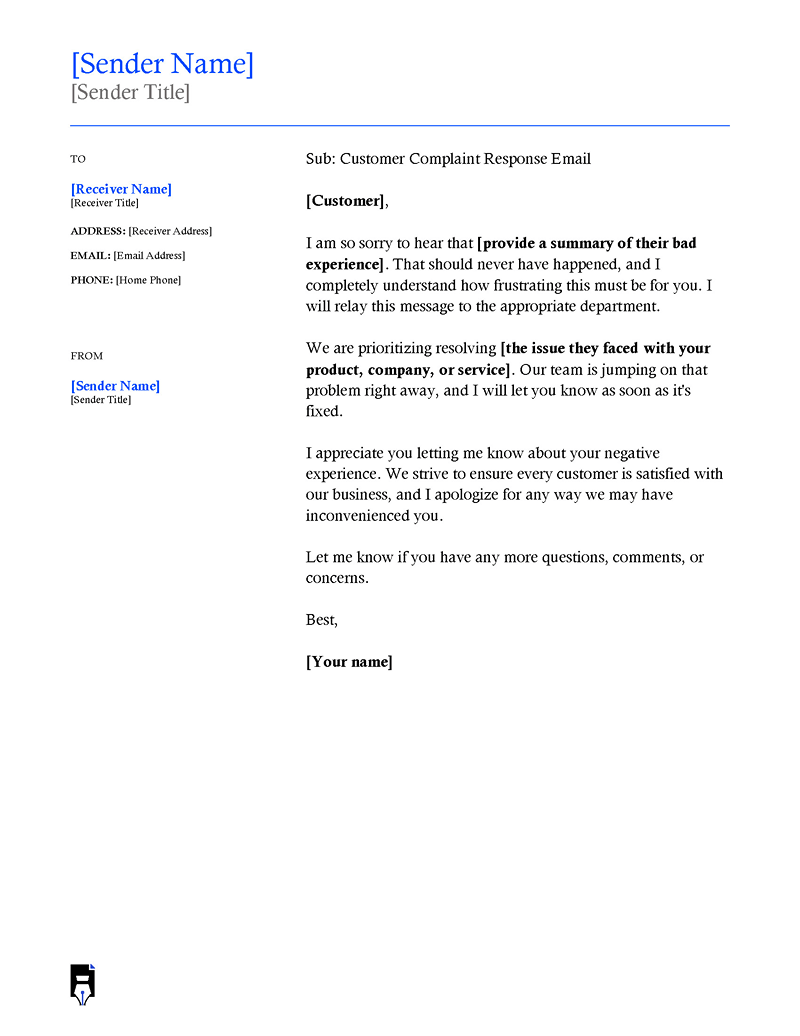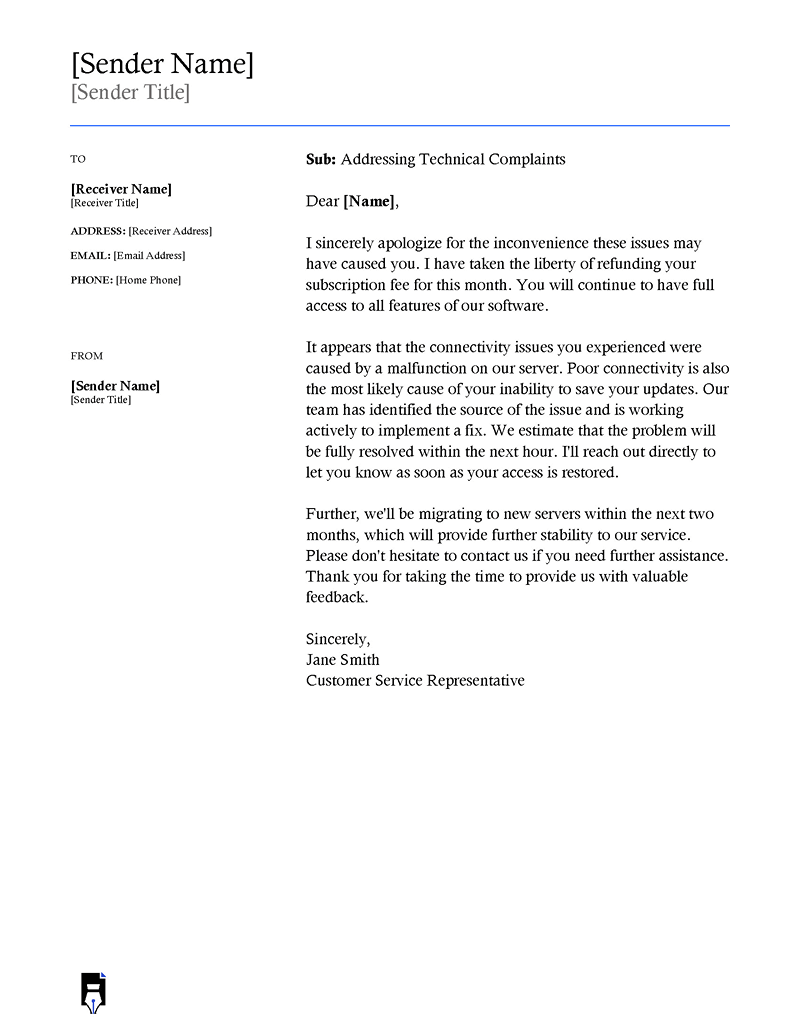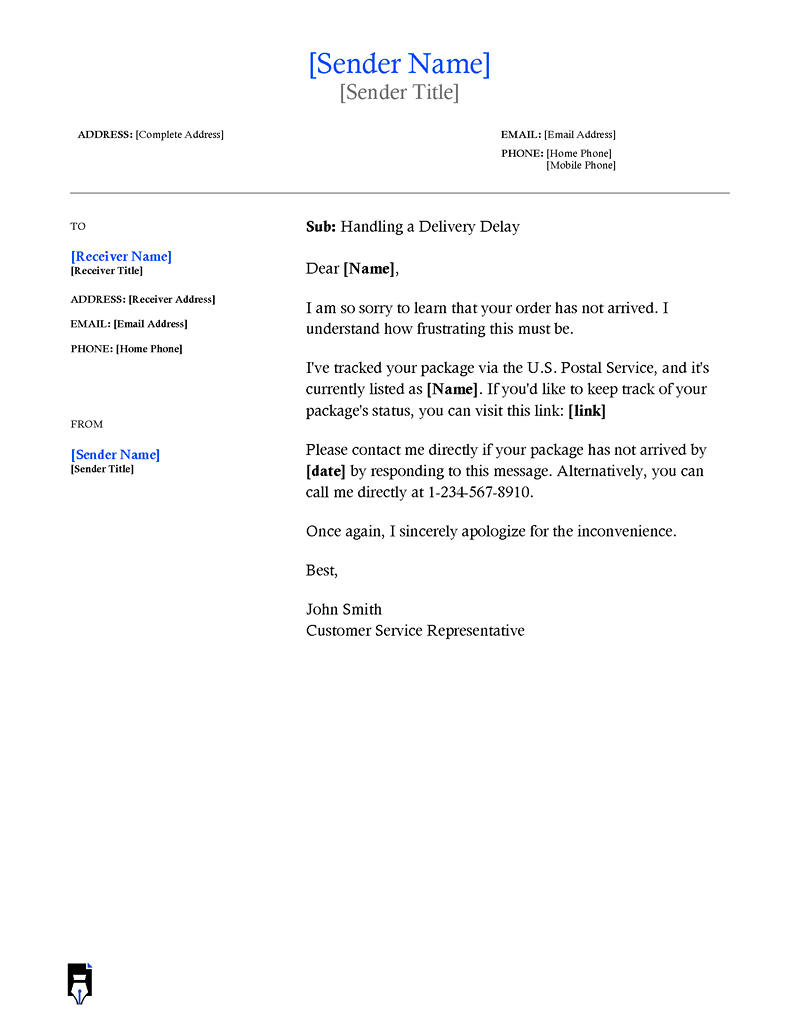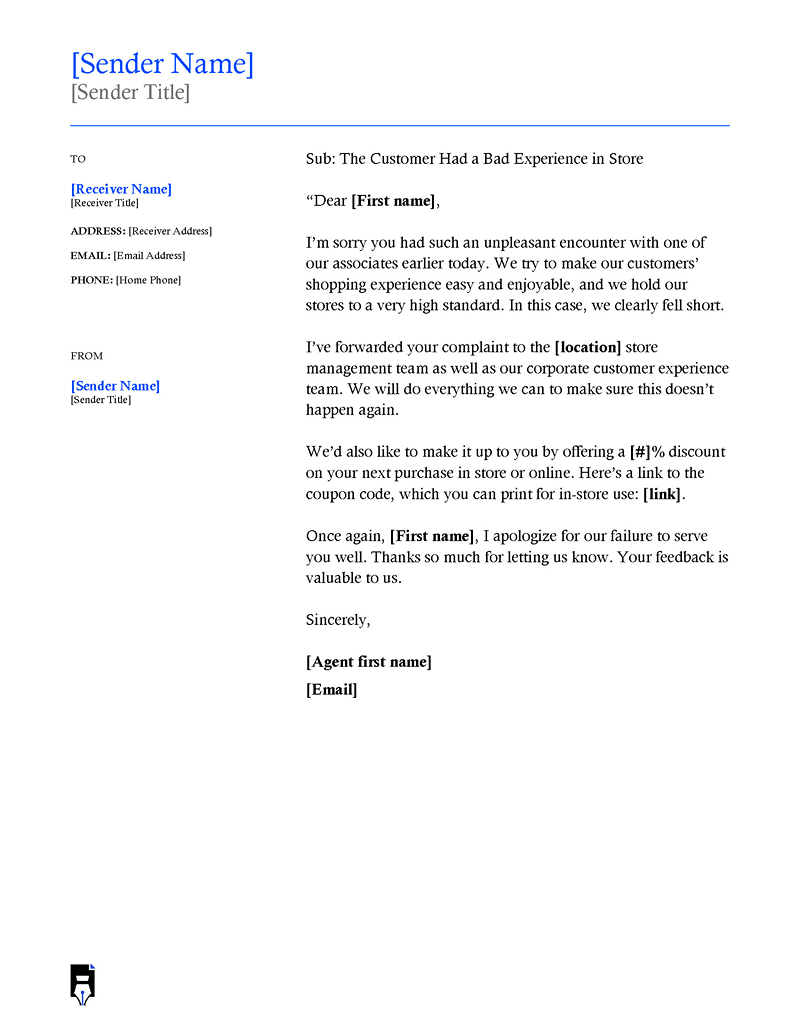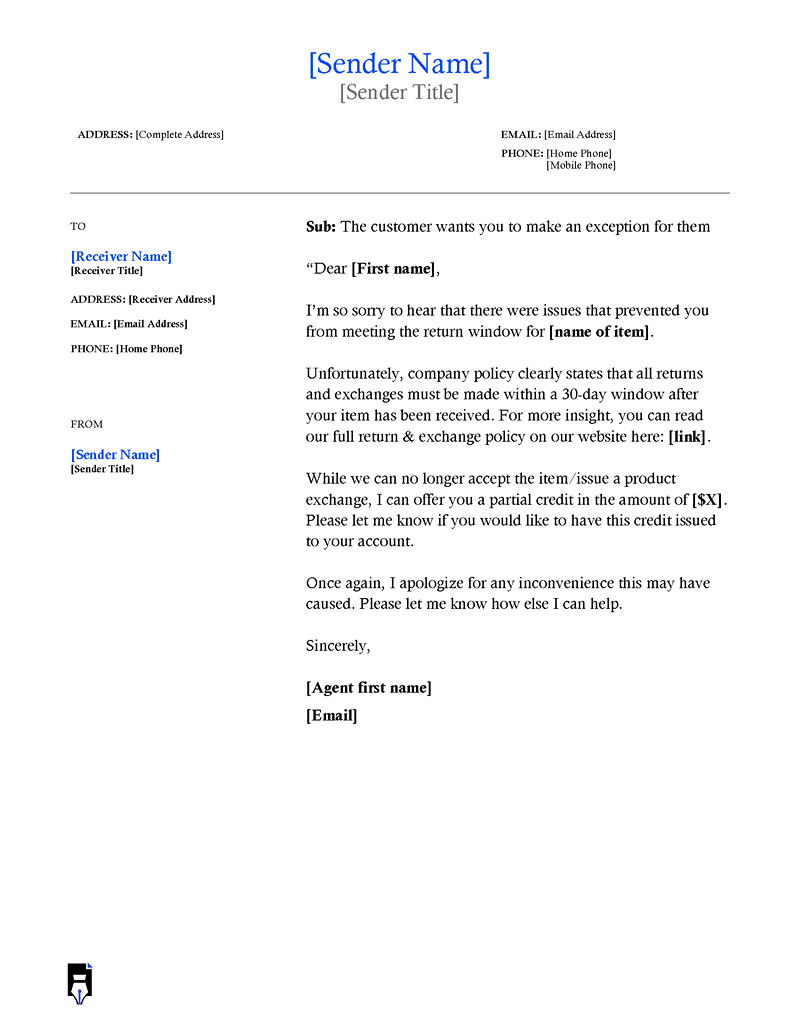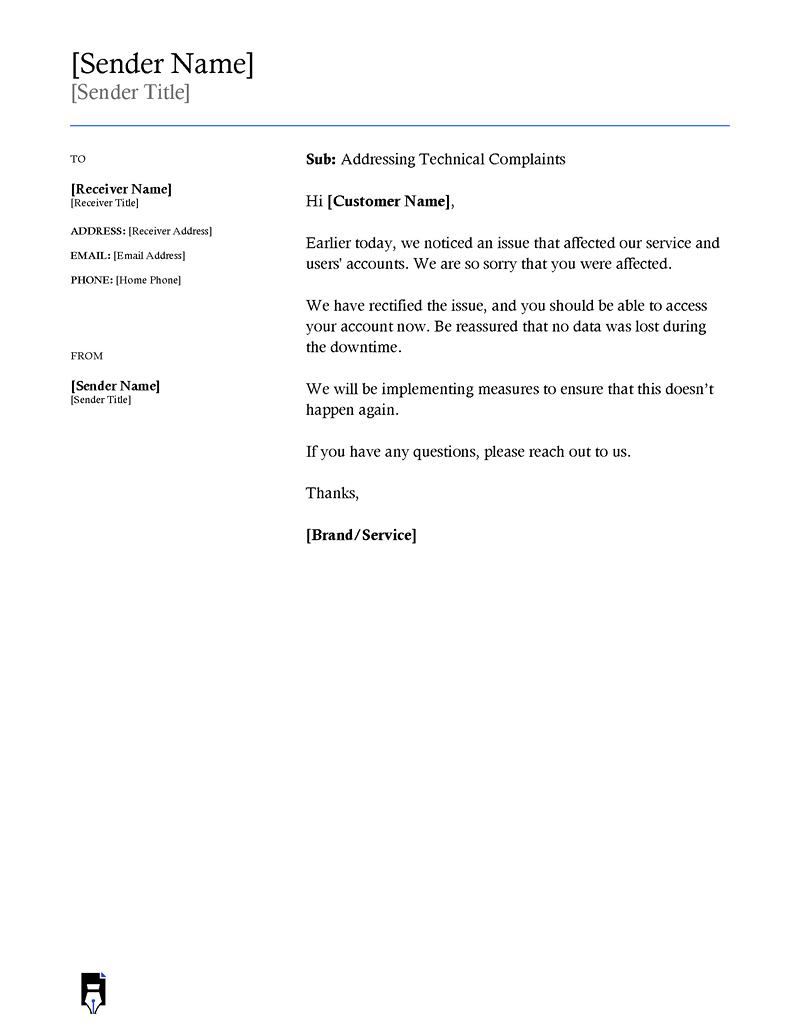A follow-up email is an email you send to a customer to acknowledge that their complaint has been received and is being attended to instantly.
A follow-up email for customer’s complaint is usually a reaction or response to the customer’s concerns/complaints. In addition, you will be able to track comments and monitor feedback. There is also flexibility to either email a handful or as many as thousands of customers.
Although sending emails remains the most effective means of follow-up to cater to customers’ complaints, there are other follow-up channels such as a letter, phone, or in-person meeting.
According to a survey, only about 4% of unhappy customers express their concern for a product or service by emailing the company. The remaining 96% will instead express their dissatisfaction to their friends and family. As a company, getting feedback on your customers’ experience, whether good or bad, helps you better understand them and figure out how to meet their expectations better. In addition, feedback has proven to help companies improve customer retention significantly.
To ensure that all customer service representatives of a company are working together to maintain a unified brand voice and value, it is advised that the customer support team is trained using standard email templates. In addition, using a shared inbox ensures proper management of customer support requests.
Customer service representatives can draft replies and exchange feedback suggestions before sending a follow-up email when faced with unusual customer complaints. Addressing a customer’s specific issues successfully and turning their negative situation into a positive experience requires that the follow-up email must be personalized to address individual preferences because each customer has a unique complaint. This will help to promote long-term relationships between your company and your customers.
The following are some reasons you may need to write a follow-up email:
- To acknowledge the receipt of a customer complaint
- To provide a solution to the customer’s dissatisfaction
- To provide a follow-up or progress report on a delivery delay
- To communicate with an angry customer
- To address complaints on technical issues
Follow-Up Email Templates
It can be challenging and time-consuming to write a follow-up email from scratch every time you need to respond to a customer’s complaint. Therefore, we have prepared customized templates for you to fill in your customer information as required. This can save you time as you do not have to start from scratch each time you want to write a follow-up email.
In addition, using these templates can help to ensure that your follow-up emails are consistent and no vital information or critical detail is missing.
Statistical Insights: Comprehensive research on 1000 companies showed that 2.4% of these companies send follow-up emails to their customers or leads. From studies, it was discovered that 2 to 3 follow-ups are sent to each customer. However, 48% of sales and customer service representatives do not send follow-ups once, while 44% eventually follow up just once and give up. It has been established that 80% of converted leads or sales require 5 follow-ups.
Importance of Follow-Up in Customer Service
The following is the importance of sending a good follow-up email and how it influences the success of the customer service team and the company:
Improve customer experience
Customers tend to be loyal to a company that offers them a good customer experience. Therefore, it is a vital aspect of customer service to send follow-up emails to respond to a complaint that contributes to the customer’s overall experience. To improve customer service, every follow-up email must embody value at each stage of interaction. In addition, responding to customers’ complaints at the appropriate moment eliminates doubts and repairs any negative experience that may have caused the customers’ complaints in the first place.
Do you know? Poor follow-up is another reason for customer complaints. A Harvard Business Review found that 56% of customers generally express dissatisfaction about poor follow-up. 48% of these dissatisfied customers eventually informed 10 other people about their dissatisfaction. Based on research by Walker 2020, poor follow-ups can ruin the entire customer experience. Poor follow-ups remain one of the most important factors determining if a customer will continue to do business with a company.
A follow-up email gives an avenue for a better understanding of the customer’s expectations from your company and how these expectations will be met.
Statistical Insights: A comprehensive study shows that 96% of customers confirmed customer service influences their loyalty to a company or brand.
Build strong customer relationships
Follow-up emails improve customer relationships because they offer the opportunity to know your customers well and understand their pain points, which eventually helps you to deliver a personalized-valuable service to each customer.
When customers contact companies that continuously communicate with them, they trust that these companies genuinely care about customer satisfaction. This is how solid and long-term customer-brand relationships are formed.
Statistical Insights: It requires 8 follow-up emails to get through to a perspective. However, a study shows that 4 out of 10 sales representatives will stop reaching out after their first follow-up attempt. 42% of prospects may go for the product or service if the sales representative sends a follow-up email at the agreed-upon time. There is a 25% probability that a sales representative will hear back from a customer if they send more than one email.
Fulfill customer expectations
A follow-up email strategy is one of the customer-centric tools that can help a company or brand successfully meet and exceed its customers’ expectations. Follow-up emails help to know customers’ needs and expectations of your company. Customers want to continue their association with the company when these needs and expectations are met. Service inquiry is one of the ways to meet customer expectations.
Retain customers
After a prospect turns to a customer, the next step is to devise means to retain customers. To boost profitability and revenue, spend your expenses on customer retention than prospect acquisition.
For example:
Your customer service or sales representatives can easily send periodic follow-up emails to your customers to better understand their pain points and expectations or notify them of bonuses and new products/services.
The follow-up responses may be negative or positive, but the customers will still feel that your company cares about their needs better than other companies would. This will make them trust the company and continues to patronize the brand.
Statistical Insights: It is five times more expensive to gain a prospect’s trust than to retain an existing customer.
Boost new sales opportunities
When sales representatives send follow-up emails to their customers, the opportunity for new sales increases. An unhappy customer would be conclusive that your company does not care if no customer service representative attempted to inquire about their experience. These unhappy customers may not want to patronize your company in the future. Follow-up emails give a customer service representative room to recognize dissatisfaction, and depending on the problem, they will be able to recommend an additional item.
Nurture old leads
Continuous communication is necessary to persuade some customers or convert old leads. Such persuasion is possible by using a strategic follow-up email approach. For example, reaching out to a person who once showed interest during a marketing campaign multiple times could result in getting a lead.
Enhance communication and get customer insights
Good communication is key to understanding a customer’s problems and delivering instant solutions. A follow-up email strategy is a tool needed to achieve good communication. With constant communication between a company’s customer service representative and its customers, both parties benefit mutually from the association. Customers feel valued, and the company also gets the opportunity to recognize areas of their service that need improvement. Customer experiences lead to increased customer satisfaction and increased revenue.
Contributes to customer viewpoint on the value
Good customer service influences the customer value the product. For example, if a product is poor but customer service is satisfactory, they may see your brand as worthy enough to remain loyal. Likewise, a customer may stay loyal to a company simply because of the company’s good customer service.
Gain a competitive advantage
Companies try to take advantage of follow-up emails to solidify their customers’ loyalty. But unfortunately, many companies either get their follow-up email wrong or do not follow up regularly. Find out where your competitors are making mistakes in the follow-up strategy, discover solutions to resolve them, and use the knowledge to gain a competitive advantage.
How to Write Follow-Up Email for Customer’s Complaint
The following are steps that should be followed when writing follow-up emails:
Step 1: Apologize for their negative experience
Ensure that the first line of your follow-up email is a heartfelt apology. Irrespective of the tone of the customer’s message, remember that a customer’s complaint is not directed toward the reader. The customer only expresses how negative they feel about the product, and the company must apologize for their dissatisfaction.
To restore the relationship with the customer, acknowledge the issue or what the company did wrong and take responsibility. Ensure you use an apologetic and empathetic tone and make it known that you are solely available at that instant to help with the problem they are facing.
Step 2: Provide context and explain what happened
When customers send their complaints, they usually have unanswered questions. Clarify the context of the problem and answer all their questions to ease the tension. Ensure you sound confident as you present the solution to the problem. Customers tend to draw their confidence from your follow-up email and eventually help to calm other customers facing a similar problem.
Step 3: Reassure customer they will not face this problem again
It does not matter if a customer’s complaint is the company’s fault. As a customer service representative, you are obligated to reassure the unhappy customer that specific steps are being taken into consideration to solve the problem and that you are taking appropriate actions to prevent the problem from reoccurring.
Inform the customer that their complaint email has necessitated company-wide action, such as holding a meeting with the product team, reviewing your sales team’s ethics, or changing your logistic partner.
Step 4: Offer an incentive, refund, or discount
Incentives, refunds, or discounts are advisable interventions whenever you fear that the customer’s angry email connotes that they may stop patronizing the brand or lead to other extreme repercussions. These incentives, refunds, or discounts serve as a gesture of saying “thank you” or “I am sorry.” For example, it is only fair to offer a full refund if the customer cannot use the product due to the company’s error.
At the same time, other inconveniences, such as order delays, can be compensated with a discount on the next purchase. A compensated customer will be encouraged to continue to patronize a company that does not only apologize for wrongdoing but also compensates them with freebies.
Step 5: Allow customers to respond with further questions, comments, or concerns
In a follow-up email, it is crucial to ask open-ended questions that allow the customer to express any unresolved concerns. This is to show that you are open to rendering further assistance if necessary. Customers should close email communication if they feel all their concerns have already been solved. The more chances customers are given to express their concerns, the more opportunity you have to help eliminate their temper through your responses.
Step 6: Follow up again with the final resolution
While you have left the last follow-up email open for more questions, it is essential to follow up with the customer within three days to give the resolution’s final status report or progress report. In addition, make a reassurance note promising the customer that you have taken appropriate steps to guarantee that the problem will not surface again.
Do’s and Don’ts for Writing Follow-Up Email
There are specific standards and ethics for composing follow-up emails. The following are the do’s and don’ts that can assist you in writing the appropriate follow-up email:
Do’s
The following are vital approaches you need to incorporate in your follow-up email:
- Use the customer’s name: A customer’s name comes first in the follow-up email. Therefore, it is essential to include the customer’s name in the greeting as it makes your email appear genuine and personalized to the customer.
- Keep in mind the customer’s conversation history: Take note of instances where a customer has communicated with the company before and figure out why they did. With this information, you can compose your follow-up email using the appropriate tone (apologetic, cheery, or helpful). For example, customers with a similar complaint in the past must be communicated in a very apologetic tone; otherwise, they will be furious.
- Be empathetic and understanding: First, get to understand the problem to know the exact questions to ask in the email for further understanding of the problem. In a situation when the customer is angry, be empathetic, remain calm, and ask questions politely. You should be the in-charge of communication. For example, when a customer seems angry, continue to be warm and pleasant in your responses.
- Always say thank you: Irrespective of what kind of issue the follow-up email addresses, always say “thank you”. Saying thank you will always matter. Appreciate customers’ patronage, their time spent on the problem, their patience during the resolution of the problem, and their effort to reach out to the company in the first place.
Don’ts
The following are mistakes you must avoid in your follow-up email:
- Don’t let too much time go by: Do not let 24 hours pass before following up with a customer’s complaints. The faster a follow-up, the higher the chances of repairing your company’s image and winning back an angry customer.
- Avoid asking yes or no questions: Use more open-ended questions to allow customers to express their concerns fully. This helps you get more detail concerning how they feel to figure out the appropriate solution.
Final Thoughts
A good follow-up email is a fundamental aspect of customer service. With the right tone and appropriate solutions in your follow-up email, you can leave smiles on the face of any angry customer and eventually meet their product-service expectations. Not only will this help you retain your customer and convert leads, but it will also help your company gain a competitive advantage in their industry.
